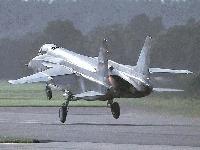我们曾经的向往
来源:百度文库 编辑:超级军网 时间:2024/04/27 20:48:13
<P>雅克-38 舰载垂直起降战斗机</P>
<P> </P>
</P>
<P>机长:15.5米 翼展:7.32米(折叠时4.88米) 机高:4.37米
正常起飞重量:7485千克 最大起飞重量:11700千克 最大挂弹量2000千克
发动机:一台留利卡设计局Aл-1涡喷发动机(8163千克×1)
两台科列索夫升力发动机(3571千克×2)
最大速度:0.95M 巡航速度:958千米/小时
实用升限:12000米
作战半径:240~556千米
武器装备:无固定武器,两侧机翼非折起段下各有两个挂架,可根据所执行的任务,选接机炮吊舱(可装23毫米双管гш-23机炮)、炸弹、火箭弹、空空导弹、空舰导弹、照相侦察舱等。
雅克-38(西方命名:Forger“铁匠”)是苏联雅克福列夫设计局研制的舰载垂直起降战斗机,主要用于对地面和海上目标实施低空攻击和侦察,并且有一定的舰队防空能力。上世纪60年代末开始研制,1971年开始试飞,1975年开始批量生产。雅克-38是专门为在“基辅”级航空母舰(排水量为37000吨)上使用而设计的,与K-25直升机一起配置在“基辅”级航空母舰上,每艘至少装备9架。该机有两种型别:雅克-38A,基本的单座型的战斗机和雅克-38B,双座教练机。 </P>
<P> 事实上,这玩意儿我们现在也许也用得着......</P>[em05]<P>雅克-38 舰载垂直起降战斗机</P>
<P> </P>
</P>
<P>机长:15.5米 翼展:7.32米(折叠时4.88米) 机高:4.37米
正常起飞重量:7485千克 最大起飞重量:11700千克 最大挂弹量2000千克
发动机:一台留利卡设计局Aл-1涡喷发动机(8163千克×1)
两台科列索夫升力发动机(3571千克×2)
最大速度:0.95M 巡航速度:958千米/小时
实用升限:12000米
作战半径:240~556千米
武器装备:无固定武器,两侧机翼非折起段下各有两个挂架,可根据所执行的任务,选接机炮吊舱(可装23毫米双管гш-23机炮)、炸弹、火箭弹、空空导弹、空舰导弹、照相侦察舱等。
雅克-38(西方命名:Forger“铁匠”)是苏联雅克福列夫设计局研制的舰载垂直起降战斗机,主要用于对地面和海上目标实施低空攻击和侦察,并且有一定的舰队防空能力。上世纪60年代末开始研制,1971年开始试飞,1975年开始批量生产。雅克-38是专门为在“基辅”级航空母舰(排水量为37000吨)上使用而设计的,与K-25直升机一起配置在“基辅”级航空母舰上,每艘至少装备9架。该机有两种型别:雅克-38A,基本的单座型的战斗机和雅克-38B,双座教练机。 </P>
<P> 事实上,这玩意儿我们现在也许也用得着......</P>[em05]
<P>
 </P>
</P><P>机长:15.5米 翼展:7.32米(折叠时4.88米) 机高:4.37米
正常起飞重量:7485千克 最大起飞重量:11700千克 最大挂弹量2000千克
发动机:一台留利卡设计局Aл-1涡喷发动机(8163千克×1)
两台科列索夫升力发动机(3571千克×2)
最大速度:0.95M 巡航速度:958千米/小时
实用升限:12000米
作战半径:240~556千米
武器装备:无固定武器,两侧机翼非折起段下各有两个挂架,可根据所执行的任务,选接机炮吊舱(可装23毫米双管гш-23机炮)、炸弹、火箭弹、空空导弹、空舰导弹、照相侦察舱等。
雅克-38(西方命名:Forger“铁匠”)是苏联雅克福列夫设计局研制的舰载垂直起降战斗机,主要用于对地面和海上目标实施低空攻击和侦察,并且有一定的舰队防空能力。上世纪60年代末开始研制,1971年开始试飞,1975年开始批量生产。雅克-38是专门为在“基辅”级航空母舰(排水量为37000吨)上使用而设计的,与K-25直升机一起配置在“基辅”级航空母舰上,每艘至少装备9架。该机有两种型别:雅克-38A,基本的单座型的战斗机和雅克-38B,双座教练机。 </P>
<P> 事实上,这玩意儿我们现在也许也用得着......</P>[em05]<P>雅克-38 舰载垂直起降战斗机</P>
<P>
 </P>
</P><P>机长:15.5米 翼展:7.32米(折叠时4.88米) 机高:4.37米
正常起飞重量:7485千克 最大起飞重量:11700千克 最大挂弹量2000千克
发动机:一台留利卡设计局Aл-1涡喷发动机(8163千克×1)
两台科列索夫升力发动机(3571千克×2)
最大速度:0.95M 巡航速度:958千米/小时
实用升限:12000米
作战半径:240~556千米
武器装备:无固定武器,两侧机翼非折起段下各有两个挂架,可根据所执行的任务,选接机炮吊舱(可装23毫米双管гш-23机炮)、炸弹、火箭弹、空空导弹、空舰导弹、照相侦察舱等。
雅克-38(西方命名:Forger“铁匠”)是苏联雅克福列夫设计局研制的舰载垂直起降战斗机,主要用于对地面和海上目标实施低空攻击和侦察,并且有一定的舰队防空能力。上世纪60年代末开始研制,1971年开始试飞,1975年开始批量生产。雅克-38是专门为在“基辅”级航空母舰(排水量为37000吨)上使用而设计的,与K-25直升机一起配置在“基辅”级航空母舰上,每艘至少装备9架。该机有两种型别:雅克-38A,基本的单座型的战斗机和雅克-38B,双座教练机。 </P>
<P> 事实上,这玩意儿我们现在也许也用得着......</P>[em05]
现在不要了:)
老了
我就不看好这个东东.[em01]
兄弟们,谁有雅克-141的图,发张上来比对一下啊……
哎,烂货拉[em05]

我喜欢141~~~
前几天不是有人发雅克141的图吗?
<P>俺们想的是YAK-141。至少这个东东有BVR和反舰打击能力,</P><P> </P><P><B>Country of Origin</B>Russia <B>Builder</B>Yakovlev <B>Role</B>air defence <B>Similar Aircraft</B><B>Span</B>33ft 1 1/2in (10.105m);
</P><P><B>Country of Origin</B>Russia <B>Builder</B>Yakovlev <B>Role</B>air defence <B>Similar Aircraft</B><B>Span</B>33ft 1 1/2in (10.105m);
folded, 19ft 4 1/4in (5.9m) <B>wing area</B>341.56ft(2) (31.7m(2)) <B>length overall</B>60ft 2 3/4in (18.36m) <B>height</B>16ft 4 1/4in (5m) <B>wheel track</B>9ft lOin (3m) <B>wheel base</B>22ft 9 1/4in (6.945m) <B>tailplane span</B>19ft 4 1/4in (5.9m) <B>Weights </B>25,684lb (11,650kg) Empty, equipped
34,833lb (15,800kg) VTO max take-off weight
42,990lb (19,500kg) STO max take-off weight
<B>Loads</B>2,204lb (1,OOOkg) VTO max external load
5,732lb (2,600kg) STO max external load
3,858lb (1,750kg) max external fuel <B>Armament</B>30 mm cannon AA-10 Alamo radar-guided medium-range AAM AA-11 Archer shortrange IR-guided missile bombs unguided rockets <B>limiting load factor</B>50% fuel, 7g. <B>Accommodation</B>Single pilot in a Zvezda K36V rocket-boosted zero-zero ejection-seat. <B>Power Plant</B>One Kobchenko/Soyuz R-79-300 vectored-thrust lift/cruise turbofan developing 34,170lb (15,500kg) with afterburning for conventional take-off, or 23,148.5lb (10,500kg) dry,
plus two Rybinsk RD- 41 turbofan lift engines each rated at a maximum 9,039lb (4,100kg) <B>Max internal fuel capacity </B>9,700lb (4,400kg) <B>Maximum Speed</B>675 kts (1,250km/hr) Max level speed, sea level
971 kts (1,800km/hr) at 36,089ft (11,OOOm)
M=1.8 max achievable Mach number <B>vertical climb rate</B>49,213ft/min (250m/sec) <B>service ceiling</B>over 49,000ft (15,000m+) <B>combat radius</B>351nm (650km) VTO range at sea level, no external weapons 372nm (690km) with 4,409lb (2,000kg) weapon load and take-off run of 394ft (120m) 755nm (1,400km) at 32,808-39,370ft (10-12,000m) 1,133nm (2,100km) max range, with external fuel and short take-off 755nm (1,400km) with vertical takeoff and internal fuel <B>Cost</B></P>
 </P><P><B>Country of Origin</B>Russia <B>Builder</B>Yakovlev <B>Role</B>air defence <B>Similar Aircraft</B><B>Span</B>33ft 1 1/2in (10.105m);
</P><P><B>Country of Origin</B>Russia <B>Builder</B>Yakovlev <B>Role</B>air defence <B>Similar Aircraft</B><B>Span</B>33ft 1 1/2in (10.105m); folded, 19ft 4 1/4in (5.9m) <B>wing area</B>341.56ft(2) (31.7m(2)) <B>length overall</B>60ft 2 3/4in (18.36m) <B>height</B>16ft 4 1/4in (5m) <B>wheel track</B>9ft lOin (3m) <B>wheel base</B>22ft 9 1/4in (6.945m) <B>tailplane span</B>19ft 4 1/4in (5.9m) <B>Weights </B>25,684lb (11,650kg) Empty, equipped
34,833lb (15,800kg) VTO max take-off weight
42,990lb (19,500kg) STO max take-off weight
<B>Loads</B>2,204lb (1,OOOkg) VTO max external load
5,732lb (2,600kg) STO max external load
3,858lb (1,750kg) max external fuel <B>Armament</B>30 mm cannon AA-10 Alamo radar-guided medium-range AAM AA-11 Archer shortrange IR-guided missile bombs unguided rockets <B>limiting load factor</B>50% fuel, 7g. <B>Accommodation</B>Single pilot in a Zvezda K36V rocket-boosted zero-zero ejection-seat. <B>Power Plant</B>One Kobchenko/Soyuz R-79-300 vectored-thrust lift/cruise turbofan developing 34,170lb (15,500kg) with afterburning for conventional take-off, or 23,148.5lb (10,500kg) dry,
plus two Rybinsk RD- 41 turbofan lift engines each rated at a maximum 9,039lb (4,100kg) <B>Max internal fuel capacity </B>9,700lb (4,400kg) <B>Maximum Speed</B>675 kts (1,250km/hr) Max level speed, sea level
971 kts (1,800km/hr) at 36,089ft (11,OOOm)
M=1.8 max achievable Mach number <B>vertical climb rate</B>49,213ft/min (250m/sec) <B>service ceiling</B>over 49,000ft (15,000m+) <B>combat radius</B>351nm (650km) VTO range at sea level, no external weapons 372nm (690km) with 4,409lb (2,000kg) weapon load and take-off run of 394ft (120m) 755nm (1,400km) at 32,808-39,370ft (10-12,000m) 1,133nm (2,100km) max range, with external fuel and short take-off 755nm (1,400km) with vertical takeoff and internal fuel <B>Cost</B></P>
<P>The Yak-141 (formerly Yak-41) was intended originally to replace Yak-38 for air defence of Kiev class carriers/cruisers, with secondary attack capabilities. Designed for carrier-borne operations as an air interceptor, close air combat, maritime and ground attack aircraft, the Yak-141 has the same multi-mode radar as the MiG-29, although with a slightly smaller antenna housed in the nose radome. It features a triplex full authority digital fly-by-wire system. </P><P>The Yak-141 continues previous Soviet V/STOL principles, combining a lift and propulsion jet with two fuselage mounted lift jets in tandem behind the cockpit, with cruise power provided by a single Tumansky R-79 jet engine. The R-79 has a rear lift/cruise nozzle which deflect down for take-off while the two lift engines have corresponding rearward vector to ensure stability. The airframe makes extensive use of composites materials, with some 28 percent by weight constructed of carbon-fibre, primarily in the tail assembly, while the remainder of the structure is mainly aluminum lithium alloys. </P><P>The project began in 1975, but was delayed by financial constraints as well as the protracted development of the engine, which meant the prototype did not fly until March 1989. This development program was cancelled due to termination of Defence Ministry funding. Yakolev OKB continued development in refined land-based and naval combat aircraft forms. Four prototypes were built, two continuing in flight testing until 1995, with the other two used for engine and structural testing. To facilitate sales of the Yak-141, Yeltsin has issued decrees allowing tri- or quadripartite agreements with a number of interested organizations in Latin America and Asia. </P><P>YAK-141是基辅级的YK-38垂直起降战斗机的替代战机,主要执行;拦截,空优和对地/海攻击及侦察等多种任务。其具备MIG-29的中距拦射能力,机头内有多模肪冲多普勒火控雷达-可能是俄罗斯RP-29/NO19。不过天线小了点,另外采用了三余度电传操纵系统。</P><P>YAK-141沿用了YK-38的V/STOL概念,即利用座舱后的两个升力发动机实现垂直起降,巡航发动机由R-79发动机担任,并且其喷口可以向下偏斜-F-35的STOL型利用的也就是这个概念,飞机主要材料是铝锂合金,但也大量采用了复合材料,如28%的碳纤维。</P><P>计划从1975年开始,由于发动机的缘故,首飞推迟到1989年,共制造4架原型机,2架试飞到95年,但因为资金问题被俄罗斯国防部放弃,叶利钦总统同意共向美洲和亚洲出售</P>
<P>可能就是传说中的YAK-141的改进型,主要外形有隐身的考虑,注意机头有折线。</P><P>YAK曾以此为基础,竞争俄罗斯空军的LFI计划。</P><P> </P>
</P>
 </P>
</P><P>座舱还是很简陋的</P><P> </P><P> 升力发动机进气口</P><P>
</P><P> 升力发动机进气口</P><P> </P><P> 喷口。</P><P>
</P><P> 喷口。</P><P> </P><P>主发动机</P><P>
</P><P>主发动机</P><P> </P><P>也 可以挂R-73,R-77的</P>
</P><P>也 可以挂R-73,R-77的</P>
 </P><P> 升力发动机进气口</P><P>
</P><P> 升力发动机进气口</P><P> </P><P> 喷口。</P><P>
</P><P> 喷口。</P><P> </P><P>主发动机</P><P>
</P><P>主发动机</P><P> </P><P>也 可以挂R-73,R-77的</P>
</P><P>也 可以挂R-73,R-77的</P>
<P>87年做过它的模型 当时觉得好复杂的说</P>
38太老了,咱买来没什么用啊
<P>90年代中期我们曾经对这个项目有兴趣,航空知识中的海外谈中国中提到,中俄联合改进,好象包括扩大机翼面积,加装整体保形油箱,可同时增加栽油量并改进气动外形减少RCS,当时还有一张三面图(预测),书我还有但我实在不愿翻仓库。</P><P>这项目当时曾被西方认为是中国发展航母的信号,但和MIG31项目一样由于俄方开价高昂,技术风险很大(雅克局当时近乎解体),有可能影响SU27的引进和消化等原因而不了了之(雅克局曾经把这个当救命稻草),直到10年后雅克才重返中国L15。</P><P>现在想想,如果当初推行这项目,成功了可以得到一种先进的海军舰载机,不成也可以对垂直起降技术有相当的了解和储备(雅克在这方面的经验是十分宝贵的)当然要考虑代价不过个人觉得挺可惜的!</P>
忘说了,我指的是YAK141